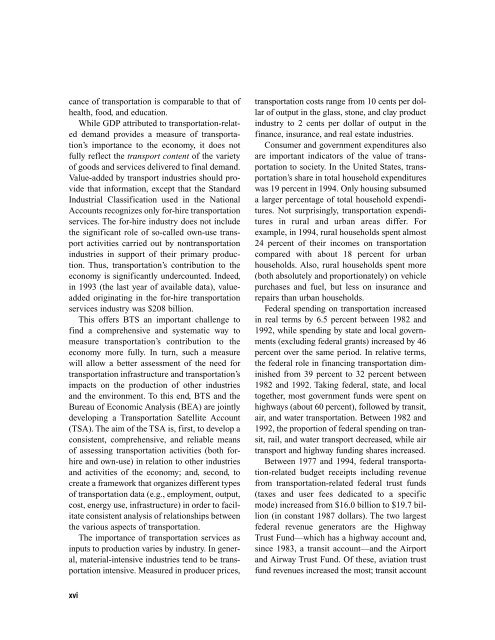table of contents - Research and Innovative Technology ...
table of contents - Research and Innovative Technology ...
table of contents - Research and Innovative Technology ...
You also want an ePaper? Increase the reach of your titles
YUMPU automatically turns print PDFs into web optimized ePapers that Google loves.
cance <strong>of</strong> transportation is comparable to that <strong>of</strong><br />
health, food, <strong>and</strong> education.<br />
While GDP attributed to transportation-related<br />
dem<strong>and</strong> provides a measure <strong>of</strong> transportation’s<br />
importance to the economy, it does not<br />
fully reflect the transport content <strong>of</strong> the variety<br />
<strong>of</strong> goods <strong>and</strong> services delivered to final dem<strong>and</strong>.<br />
Value-added by transport industries should provide<br />
that information, except that the St<strong>and</strong>ard<br />
Industrial Classification used in the National<br />
Accounts recognizes only for-hire transportation<br />
services. The for-hire industry does not include<br />
the significant role <strong>of</strong> so-called own-use transport<br />
activities carried out by nontransportation<br />
industries in support <strong>of</strong> their primary production.<br />
Thus, transportation’s contribution to the<br />
economy is significantly undercounted. Indeed,<br />
in 1993 (the last year <strong>of</strong> available data), valueadded<br />
originating in the for-hire transportation<br />
services industry was $208 billion.<br />
This <strong>of</strong>fers BTS an important challenge to<br />
find a comprehensive <strong>and</strong> systematic way to<br />
measure transportation’s contribution to the<br />
economy more fully. In turn, such a measure<br />
will allow a better assessment <strong>of</strong> the need for<br />
transportation infrastructure <strong>and</strong> transportation’s<br />
impacts on the production <strong>of</strong> other industries<br />
<strong>and</strong> the environment. To this end, BTS <strong>and</strong> the<br />
Bureau <strong>of</strong> Economic Analysis (BEA) are jointly<br />
developing a Transportation Satellite Account<br />
(TSA). The aim <strong>of</strong> the TSA is, first, to develop a<br />
consistent, comprehensive, <strong>and</strong> reliable means<br />
<strong>of</strong> assessing transportation activities (both forhire<br />
<strong>and</strong> own-use) in relation to other industries<br />
<strong>and</strong> activities <strong>of</strong> the economy; <strong>and</strong>, second, to<br />
create a framework that organizes different types<br />
<strong>of</strong> transportation data (e.g., employment, output,<br />
cost, energy use, infrastructure) in order to facilitate<br />
consistent analysis <strong>of</strong> relationships between<br />
the various aspects <strong>of</strong> transportation.<br />
The importance <strong>of</strong> transportation services as<br />
inputs to production varies by industry. In general,<br />
material-intensive industries tend to be transportation<br />
intensive. Measured in producer prices,<br />
xvi<br />
transportation costs range from 10 cents per dollar<br />
<strong>of</strong> output in the glass, stone, <strong>and</strong> clay product<br />
industry to 2 cents per dollar <strong>of</strong> output in the<br />
finance, insurance, <strong>and</strong> real estate industries.<br />
Consumer <strong>and</strong> government expenditures also<br />
are important indicators <strong>of</strong> the value <strong>of</strong> transportation<br />
to society. In the United States, transportation’s<br />
share in total household expenditures<br />
was 19 percent in 1994. Only housing subsumed<br />
a larger percentage <strong>of</strong> total household expenditures.<br />
Not surprisingly, transportation expenditures<br />
in rural <strong>and</strong> urban areas differ. For<br />
example, in 1994, rural households spent almost<br />
24 percent <strong>of</strong> their incomes on transportation<br />
compared with about 18 percent for urban<br />
households. Also, rural households spent more<br />
(both absolutely <strong>and</strong> proportionately) on vehicle<br />
purchases <strong>and</strong> fuel, but less on insurance <strong>and</strong><br />
repairs than urban households.<br />
Federal spending on transportation increased<br />
in real terms by 6.5 percent between 1982 <strong>and</strong><br />
1992, while spending by state <strong>and</strong> local governments<br />
(excluding federal grants) increased by 46<br />
percent over the same period. In relative terms,<br />
the federal role in financing transportation diminished<br />
from 39 percent to 32 percent between<br />
1982 <strong>and</strong> 1992. Taking federal, state, <strong>and</strong> local<br />
together, most government funds were spent on<br />
highways (about 60 percent), followed by transit,<br />
air, <strong>and</strong> water transportation. Between 1982 <strong>and</strong><br />
1992, the proportion <strong>of</strong> federal spending on transit,<br />
rail, <strong>and</strong> water transport decreased, while air<br />
transport <strong>and</strong> highway funding shares increased.<br />
Between 1977 <strong>and</strong> 1994, federal transportation-related<br />
budget receipts including revenue<br />
from transportation-related federal trust funds<br />
(taxes <strong>and</strong> user fees dedicated to a specific<br />
mode) increased from $16.0 billion to $19.7 billion<br />
(in constant 1987 dollars). The two largest<br />
federal revenue generators are the Highway<br />
Trust Fund—which has a highway account <strong>and</strong>,<br />
since 1983, a transit account—<strong>and</strong> the Airport<br />
<strong>and</strong> Airway Trust Fund. Of these, aviation trust<br />
fund revenues increased the most; transit account

















